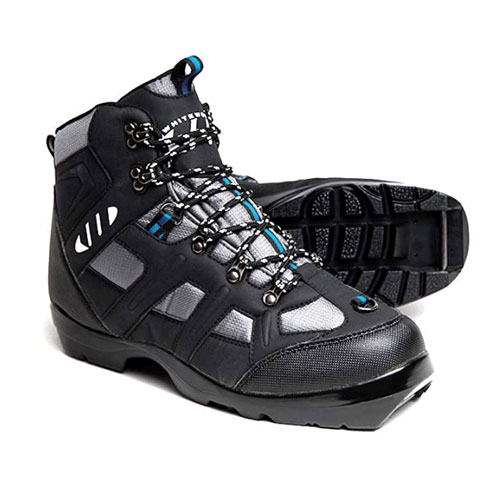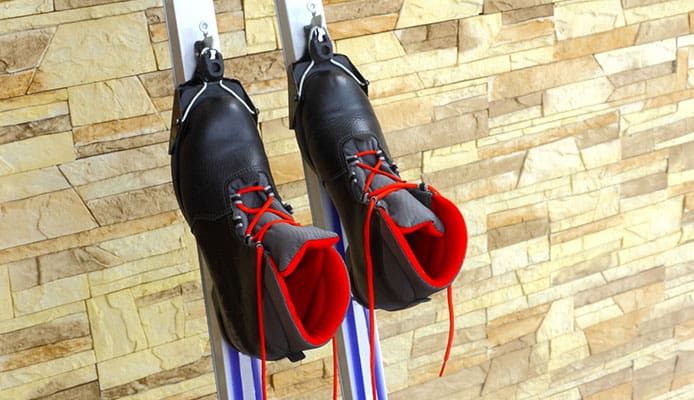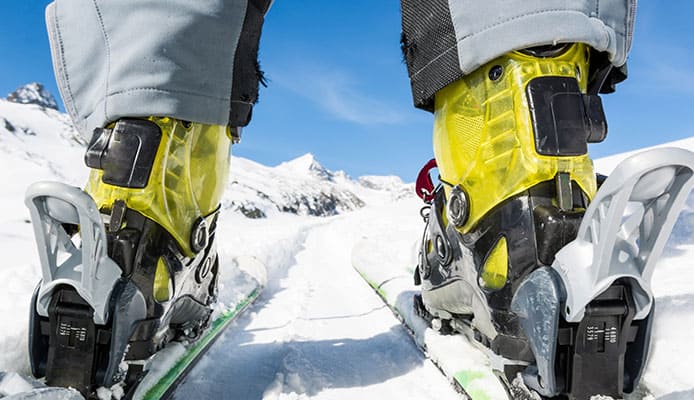
Often overlooked when compared to alpine skiing, its more glamorous brother, cross country skiing, also called nordic skiing, is a great way to stay fit during the winter and explore the mountains in a different way. The high speeds you may reach while sliding down the slopes can provide adrenaline and excitement, but gently gliding between the mountains will make you connect with nature in a way you would not have expected.
As with any outdoor activity, and specifically the ones that have to do with snow, the gear you have with you is crucial to your enjoyment of the experience. In this article, we will take a look at the best cross country ski boots you can buy. Their job will be to keep your foot nice and warm while working in unison with the ski to propel you along the snow. Flexibility, durability and fit are some of the main characteristics you should be looking for, so join us as we take a look at the best options the market has to offer.
OUR TOP PICK
Alpina Blazer 75mm
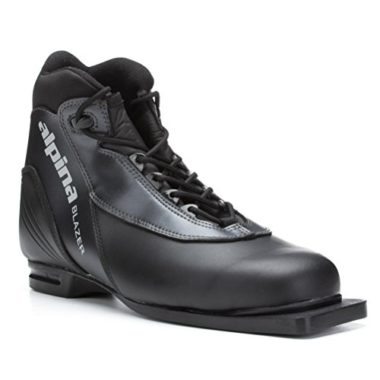
- Stand Out Features - Why We Love It
- Soft but durable boot offers great freedom of movement
- Thinsulate insulation
- Easy to use lace system
- Molded heel
Size: 36-49
Upper: Synthetic
Binding Compatibility: 75mm
EDITORS CHOICE
Whitewoods New Adult 75mm
- Stand Out Features - Why We Love It
- Anatomic footbed for maximum comfort
- Thinsulate insulation
- Protective layer around the toe
- Unisex model
Size: 36-49
Upper: King-Tex
Binding Compatibility: 75mm
BEST VALUE
Alpina Alaska NNN-BC
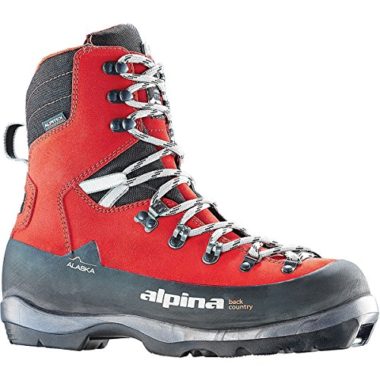
- Stand Out Features - Why We Love It
- Medium flex is strong enough for rougher terrain
- Waterproof
- Made of natural leather
- Soft ankle collar
Size: 39-47
Upper: Leather
Binding Compatibility: NNN BC
Rossignol X-2 XC
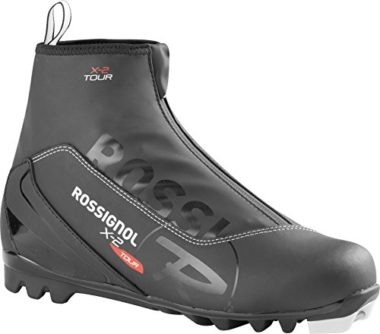
- Stand Out Features - Why We Love It
- Great model for beginners
- Thinsulate insulation
- Reinforced heel
- Quick tension laces
Size: 40-44
Upper: PVC
Binding Compatibility: NNN
Salomon Escape 7 Prolink XC
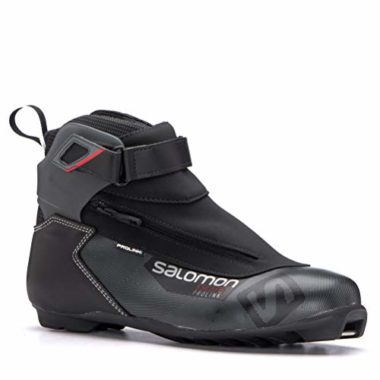
- Stand Out Features - Why We Love It
- Easy to fasten and unfasten
- Thinsulate insulation
- Waterproof coating
- Excellent ankle support
Size: 8-16 (US)
Upper: Synthetic
Binding Compatibility: SNS, compatible with NNN
How To Choose Cross Country Ski Boots – Buying Guide
Size
The size of your cross country ski boots is a crucial factor in determining how efficiently you can push yourself through the snow. Even the best Nordic ski boots won’t be of much help if they are not the correct size since the movement of your foot inside them will make you lose much of the energy that should be transferred to the ski. Luckily, your everyday shoe size is a good starting point to choose which boots to buy, since they follow the same system. Keep in mind that you will probably be wearing thick socks to keep you warm while you’re skiing, so you might want to allow a little extra space for those. All models will feel a little stiff when you take them out of the box but that is a good sign. They will adapt to the shape of your foot with time, after the breaking-in period, so if you’re worried about finding cross country ski boots for wide feet you can rest assured the market has you covered.
Related Review: Ski Boots For Wide Feet
Insulation
Good insulation is a must-have for cross country ski boots. This kind of activity will have you spending long hours in the snow, and this is simply inconceivable if your feet are not warm. Manufacturers are well aware of this and all of the models we have presented on our list feature some kind of insulation. The best cross country ski boots usually come equipped with Thinsulate protection, the top of the line option, and are guaranteed to keep your feet well protected at all times. They might come at a slightly higher cost but when it comes to gear items such as these it is worth spending a little more, so you won’t end up paying when you’re out on the slopes.
Related Review: Ski Boots For Narrow Feet
Support
The amount of support you will need from your boots, especially for your ankles, will depend on the terrain you plan to use them on as well as the skiing technique you choose. Skating will place much more strain on your joints than the regular diagonal skiing, so the most basic cross country ski boots might not guarantee the amount of protection and stiffness you need. Carefully planning your trip before you head out will let you accurately predict what you need your gear to do, so you can know in advance which are the items that will help you the most.
Waterproof
As with any piece of gear that you plan to take out on the snow, a defence against water and humidity is paramount. Think of the discomfort that wet socks cause and multiply it by at least one hundred since you won’t have any dry pair available if you’re far away from everything on the side of a mountain. The best cross country ski boots all feature some kind of waterproof layer on the outside, and those are the ones you should look for. This is another case where paying a little more for a product will save you a great number of problems later on. Be careful though, as some manufacturers will not pay so much attention to waterproofing since cross country skiing is believed to be a fair-weather sport.
Binding Compatibility
Pay close attention to the binds on your skis before buying boots, since incompatibility is not rare. Depending on the style of cross country skiing you plan to do, your choice has to go in precise directions. The most common bindings are New Nordic Norm (NNN) and Nordic Integrated System (NIS), which will both function with NNN or NIS boots. These will work on groomed trails and off-trail skiing that doesn’t arrive on to extreme terrain. Other available bindings are 75mm 3-pin and New Nordic Norm Backcountry (NNN BC). These are wider and bulkier and will not work for in-track skiing, but thanks to their strength they are best suited for ungroomed terrain. 75mm bindings, however, are an older model that is slowly falling out of production. Lastly, for groomed tracks, the Salomon Nordic System (SNS) binding is available. It is only compatible with SNS boots and sits slightly higher than NNN boots for extra leverage when you around turns.
Cushioning
Cushioning will prove essential after you spend several hours on the snow. Your ankles and heels will be the first parts to start feeling sore, so look for boots that provide soft surfaces around or under them to reduce the pain. A little discomfort is normal after you’ve spent hours on the tracks, but the best cross country ski boots will go to great lengths to keep it to a minimum and let you enjoy the experience to the full.
FAQs
Q: Do I Need Special Boots For Cross Country Skiing?
Yes, you do. Just like for any other activity that involves skiing, you need a dedicated pair of boots that will allow you to remain attached to the skis. Unfortunately, there is not really a way around this or some trick you can use to cross country ski without boots. You need a good pair that will make you feel warm and comfortable and that is flexible enough to allow for the movements you need to make.
Q: What Size Cross Country Ski Boots Do I Need?
Luckily, for cross country boots you can rely pretty accurately on your normal shoe size. They follow the same logic, so you won’t find yourself having to do complicated calculations or conversions, except if you’re not used to European or American measurement. In any case, it is best to try on your boots before you head out to make sure if the fit is indeed correct, and in case return them. You might even try and buy a slightly smaller sized boot to ensure a tighter fit which will give you better control on the movements of your feet. However, if you consider the fact that you will be wearing heavy socks under your boots, it could be better to stick to your usual size or even go slightly bigger.
Q: What Are Cross-Country Ski Boots?
Cross country boots are a crucial part of crosscountry skiing equipment. Their role is to fasten your toe to the ski binder while leaving the heel free so you can correctly execute the movements that propel you through the snow. There are several types of cross country ski boots available. The classic type is usually lighter and thinner and with a tougher heel counter for increased power transfer. These are perfect for regular cross country skiing techniques. Skiers who use skate style can use skate cross country boots, which are tougher to sustain the higher stresses this technique entails and also feature a stiff sole for a more powerful kick. Finally, combi cross country ski boots bring together features from both models, with a soft sole like in classic boots and a reinforce ankle like in skate boots. This type of boot gives you the best of both worlds and gives you the maximum freedom when out on the trail.
Q: How Tight Should Cross-Country Ski Boots Fit?
Your cross country ski boots should wrap snugly around your foot, without being too tight. Do not be alarmed if the tip of your toe doesn’t touch the front of the boot, this will not affect the boot’s performance. The tightness of the fit will influence the efficiency of your motion, with a looser fit being more comfortable but better for recreational use. If your foot moves around inside the boot the power transfer to the ski will not be as smooth and efficient as it should. The amount of force that can be transferred to the ski greatly depends on the fit of your heel. If you feel it rising up after you push it means the boot is too loose and much of the effort you are putting in is going wasted, so pay attention to how the boots feel before you put them into action.
Globo Surf Overview
There is not a huge amount of gear required to go cross country skiing, but this means you should pay special attention to every part of it. Boots, in particular, may not seem the most crucial, but their role will show all of its importance as soon as you’ve glided for a couple of miles. In our cross country ski boots reviews we have highlighted what are the best choices for items that can be used both as men’s or as women’s cross country ski boots. This will enable you to make an informed decision and head out on the slopes with a product you know you can trust on your feet. Take your time to make an informed decision and you won’t come back to buy another pair anytime soon.
More Snow Ski Gear Reviews:
- Ski Pants
- Cross Country Ski Gloves
- Skiing Books
- Backcountry Ski Bindings
- Women Ski Boots
- Women’s Skis
- Watches For Skiing
- Ski And Snowboard Tuning Vises
- Ski And Snowboard Wall Racks
- Kids Ski Helmets
- Ski Gloves For Kids
- Photochromic Ski Goggles
- Ski Boots For Kids
- Kids Ski Poles


